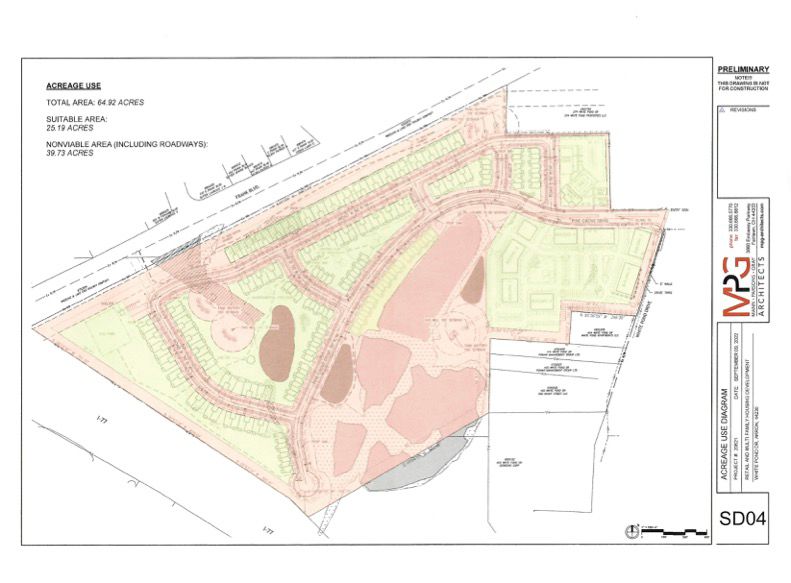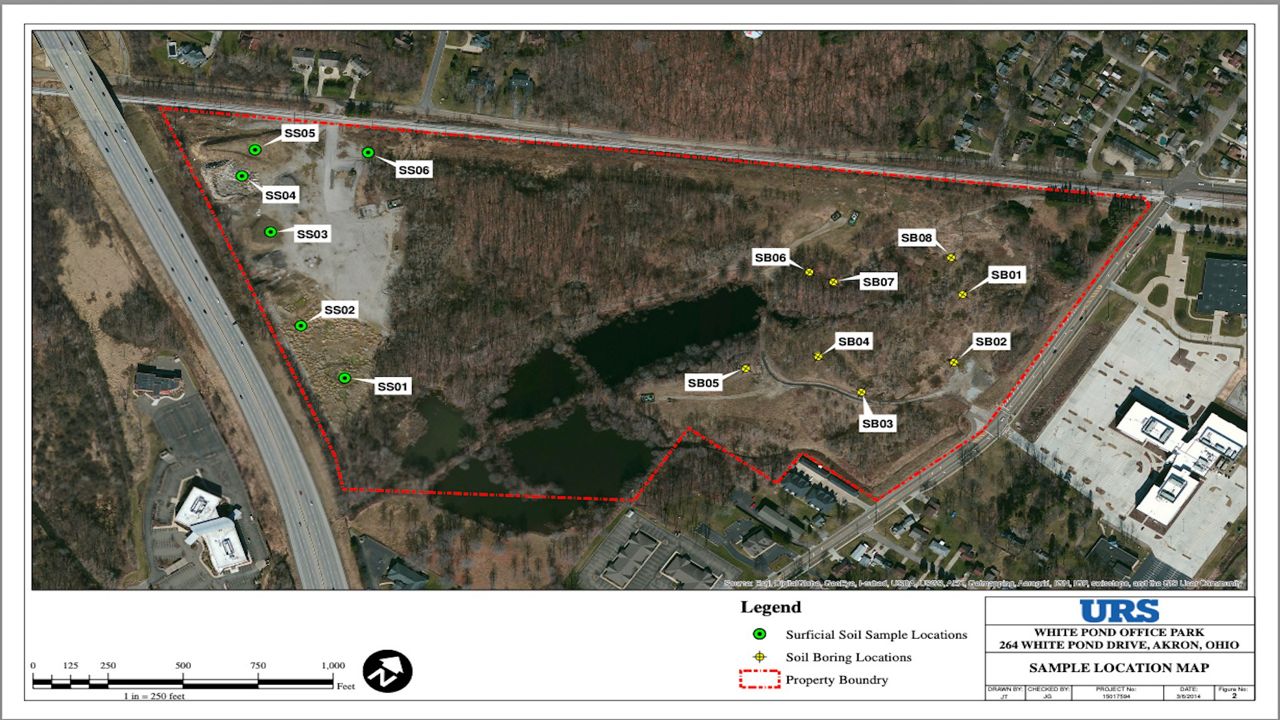AKRON, Ohio – Groups opposing a residential development are expected to fill City Hall Monday night in a last push to have the plan abandoned entirely or put on hold until April 2023.
Under the project plan, Triton Properties Ventures LLC is expected to buy 65 acres of city-owned property at White Pond in West Akron for $750,000 to build townhomes and apartments, a pool, a tennis court, a dog park and pickle ball courts, as well as retail space.
There’s no chance sale of the property will be postponed because it “would effectively kill the entire development,” the city said in an email. “That delay would result in the developer walking away from the project.”
Officials said they aren’t convinced delaying the sale would be of benefit. Some have questioned whether the request for a delay until April is politically motivated. Akron’s primary is in May, with all council members up for re-election.
Meghan Lugo, an assistant professor in the University of Akron, was among the earliest protestors and has become a de facto voice for those who oppose the development.
“I think it was just that April was a six-month timeframe that we came up with,” she said. “Honestly, I don't think it's political.”
Lugo and others who oppose the development say the city doesn’t give enough of an opportunity for citizens to weigh in on plans like this one, or on other local developments.
“They feel like they've done their procedural due diligence, but the citizens are feeling like these procedures don't allow for them to adequately not only share their voice, but actually have their voice shape the future of their neighborhoods,” Lugo said.
In most cases, the city works out such deals behind the scenes and only brings the development to the public when details been settled, she said.
In his monthly Ward 8 newsletter, Councilman Shammas Malik supported that theory, saying he has questioned the city’s approach to development.
“Often a developer works with the city administration to put together a plan for a particular piece of land, with a lot of time and energy (and money) put into it before anything is announced to the public/council, making it difficult for council to make significant changes beyond a ‘yes’ or ‘no’ vote,” he wrote.
Malik said he would support the White Pond plan, which he said is “relatively thoughtful … for an area that has long been slated for development, by a developer that has been very transparent, is based in Akron and is willing to make significant investment in the project.”
Development at the White Pond site first surfaced publicly years before the current proposed sale, said Mayor Dan Horrigan, and opportunities for public input have been offered many times since.
The idea to develop the site started when the city bought the land in 2006, initially looking for office space because that’s what was needed, the city said. The property was rezoned and public hearings were held at both the Planning Commission and at City Council.

Public hearings were held again in 2022 when the city adopted the site’s development plan and approved conditional use for the land, the city said.
Public hearing notices were sent to 62 residences near the site, twice, officials said.
“It’s completely inaccurate to characterize us as not talking. Did we talk every time somebody asked us? We may have issued a statement, we may have talked to a reporter, we may have had experts talk to somebody but we've not been radio silent,” Horrigan said. “To me, it's a lot of a disagreement about what the answers are.”
Protestors also have cited concerns about destruction of wetlands on the property, including several small ponds and streams, and pointed to the site as potential habitat for the endangered Indiana bat.
In 2007, original plans for an office development included dredging or filling about 13 acres of wetlands and streams so the city paid $392,000 for wetland mitigation credits through the U.S. Army Corps of Engineers, officials said.
Mitigation credits, allowed under the Clean Water Act, were to enable the loss of smaller, isolated wetlands under the assumption banking wetland acreage at a comparable but maintained wetland site can mitigate damage to an ecosystem.
Akron’s credit equated to 14 acres of new wetlands at Panzer Wetland Wildlife Reserve, which in 2012 was donated to the University of Akron, and is home to the only colony of endangered wood turtles in Ohio, the city said.
But under current plans, Triton will leave about 25 acres of the property, including the wetlands, as natural landscape and build a public walking trail to make the wetlands accessible, the city said.
To serve the endangered bat, the developer will be required to follow preservation efforts set forth by the Army Corps of Engineers in 2009 involving specific tree characteristics deemed important for the federally listed creature’s summer habitat.
Live or dead trees with peeling bark, split trunks or cavities that can be used as “maternity roosts” must be preserved, according to the Army Corps of Engineers.
If such trees exist on the property, they cannot be cut between April 1 and September 30, which the city cites as another reason the project can’t be postponed until April.
An Army Corps of Engineers study found no indication the property is a habitat for bald eagles, which were taken off the endangered species list in 2007, but are still protected under the Migratory Bird Treaty Act and the Bald and Golden Eagle Protection Act.
But Lugo said White Pond-area residents have seen bald eagles at the site.
The city said in that case, residents should contact the Ohio Department of Natural Resources Division of Wildlife management and report their concerns.
Protesters also say some of the reports the city is relying on are old and not reliable, Lugo said.
Agencies like EPA and Army Corps of Engineers have approved projects like the Keystone Pipeline, she said, so they aren’t interested in what’s good for the environment. They exist to uphold the law as it pertains to the environment.
“When you clear cut the acres of trees that surround wetlands, and then you put like cars and lawns with fertilizer and construction material, you will, like downstream, literally and figuratively, potentially create dead zones,” she said. “There will be no wildlife, flora or fauna in those areas.”
Lugo said the city should work with professionals who live in the White Pond area on environmental issues surrounding the development.
The environmental reports were undertaken in an attempt to bring the property back into the marketplace, the city said, and can help potential developers understand what might be needed to redevelop the property.
“There is no reason to use taxpayer funds to conduct further environmental studies on the property when we have already done our environmental due diligence to bring the blighted property back into the marketplace and a private developer is now prepared to conduct any necessary studies required by environmental regulators,” the city said.
Among the city’s reasons for developing the site for residential rather than office space is part of the city’s push to grow the population, Horrigan said.
The pandemic demonstrated people can work from home for employers located just about anywhere, he said. During his tenure, two studies have been conducted on housing and both concluded affordable and market-rate housing is needed.
“If we're trying to attract people here, and maybe they do want to work from home, maybe they want a shorter commute, maybe they want to do these things, you need to be in multiple different levels of a market to be successful,” he said. “There's a balance in housing that we need to have. This fills that need.”
Although some have pointed to the Innerbelt as a better site for residential development than White Pond, which Horrigan said is not a fair comparison, as the investment needed to make it ready for development would be upwards of $10 million of public money.
“This is site ready, because we've been working on it since 2004 or 2005, with Ohio EPA, with the Army Corps of Engineers,” Horrigan said.
Protestors doubt the developer’s ability to undertake a residential development of this magnitude, Lugo said.
Triton offers a list of properties it developed under California’s strict environmental regulations, the city said.
“We feel confident the developer is more than qualified to develop this site abiding by all necessary laws and regulations,” the city said.
City Council is expected to vote on the project at its regular meeting Monday, Dec. 12 at 7 p.m.



